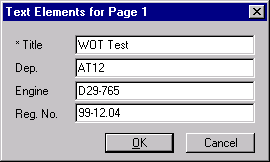auto_ReplaceTextDialog¶
auto_ReplaceTextDialog can be used within an automation script to show a text dialog box.
-
bool = auto_ReplaceTextDialog() -
bool = auto_ReplaceTextDialog(hPage) -
bool = auto_ReplaceTextDialog(ssNetCDFName) -
bool = auto_ReplaceTextDialog(hPage, ssNetCDFName) -
bool = auto_ReplaceTextDialog(ncid) -
bool = auto_ReplaceTextDialog(hPage, ncid)
Return Value
bool is TRUE (1), when the function was successful and otherwise FALSE (0).
Parameters
-
hPage hPage is the handle of the page where the text should be edited. If this parameter is not entered or is entered with the value 0, the active page will be used. The active page is the top most page appearing on the monitior.
-
ssNetCDFName ssNetCDFName is the complete netCDF file name.
-
ncid Identifies the netCDF file.
Comment
If the function is called without the parameter hPage, the function uses the last page created with the auto_LoadTemplate function.
The function searches the page for placeholders. A place holder is a text
enclosed with $ symbols. i.e. $User$. Place-holders can be used in
text objects and in the diagram axes titles.
If a place-holder is not found in the text of a text object, this function searches the text object’s name for one. If a place-holder is found in the name, the text of a text object will appear in a dialog box in order for it to be edited.
When the ssNetCDFName parameter is entered, the place-holder will be looked for in the NC file. Please note the following:
To access a global attribute, the name of the attribute should be
entered. For example: "Origin".
To access an attribute of a specific variable, the name of the
variable should be separated from the attribute name with a period.
For example: $Torque.long_name$.
Siehe auch: Text Placeholder.

History
| Version | Description |
|---|---|
| 5.4.0 | New parameter ncid. This parameter can be used instead of the file name. |
See also
Overview Automation, auto_ReplaceText, auto_ReplaceTextFromNCFile, auto_GetFileNameDialog, auto_ImportData, Text Placeholder
id-1813745